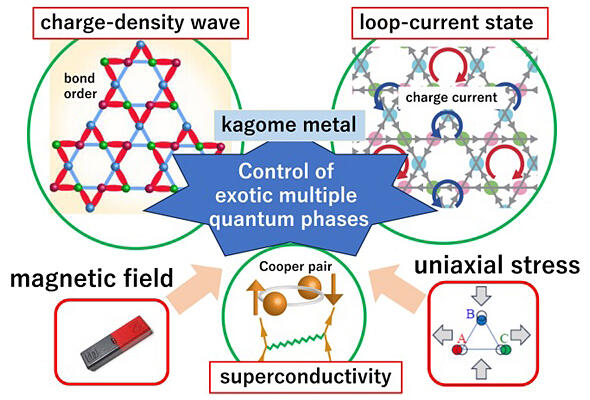In the kagome lattice metal AV3Sb5 (A = Cs, Rb, or K), a new type of superconductor, novel quantum phases have been identified, including a loop current phase characterized by nanoscale permanent current flow, charge ordering accompanied by a David star pattern, and an electronic liquid crystal phase with broken rotational symmetry. These distinct quantum phases coexist and manifest within the material. The capacity to freely control multiple quantum phases is highly attractive and offers a plethora of possibilities, including device applications.
Lecturer Youichi Yamakawa and Professor Hiroshi Kontani from the Graduate School of Science at Nagoya University, along with Assistant Professor Rina Tazai from the Yukawa Institute for Theoretical Physics at Kyoto University, have jointly developed a theory that predicts the emergence of novel multiple quantum phases in metallic compounds possessing kagome lattice structures. These phases can be controlled by a small external field. The results were published in PNAS (Proceedings of the National Academy of Sciences of the United States of America).

Provided by Nagoya University
To gain a thorough understanding of the multiple quantum phases present in kagome metal, the research group has formulated a theory focused on clarifying the various quantum phases that emerge in kagome metal under the influence of external fields, including magnetic and uniaxial strain fields. Their approach is based on the Ginzburg-Landau free energy theory.
In kagome metals, the induction of a loop current phase occurs simply by applying a small magnetic field to a single phase of pure charge ordering. This results in the realization of a two-phase coexistent phase. The magnetic field-induced current is directly proportional to the intensity of charge ordering and exhibits an increase at low temperatures. Furthermore, it has been observed that the coexisting phase of current and charge is significantly enhanced by even a small uniaxial strain field. This theoretical proposal is highly versatile as it allows for the external field control of not only the quantum phases specific to kagome metals but also those found in various other metals, such as high-temperature superconductors.
The phase transition is a phenomenon that arises from the interaction between electrons. The presence of multiple quantum phases in kagome metals implies that the interactions responsible for charge ordering and those responsible for loop currents are antagonistic to each other. The research group has provided an explanation for this phenomenon based on a quantum field theory known as the renormalized group. In the method of calculating the low-energy effective interaction responsible for the phase transition without making assumptions, they started from the calculation of the high-energy component, the nature of which is known. In turn, they performed the calculation iteratively and finally reached the low-energy component.
This procedure can be executed by solving the renormalization group differential equation.
The group discovered that in kagome metals, the strength of the interaction causing charge ordering and loop currents develops antagonistically. Subsequently, the superconducting interaction emerges. This observation aligns with the transition temperatures observed in kagome metals. Specifically, the transition temperatures are approximately 100 K for the charge ordering and loop current phase transitions, while the superconducting transition occurs at approximately 10 K.
In the near future, it is anticipated that applications will be developed for novel devices harnessing the quantum phases present in kagome lattice metals, based on the insights provided by this theory.
Journal Information
Publication: PNAS
Title: Drastic magnetic-field-induced chiral current order and emergent current-bond-field interplay in kagome metals
DOI: 10.1073/pnas.2303476121
This article has been translated by JST with permission from The Science News Ltd. (https://sci-news.co.jp/). Unauthorized reproduction of the article and photographs is prohibited.




